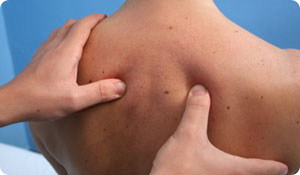
Many chronic pain patients have run out of options for relief. Some physicians are now prescribing trigger point therapy, otherwise known as myofascial therapy, for chronic pain patients.
There is growing evidence that chronic pain--as well as most of our common aches and pains--are actually caused by trigger points, or small contraction knots, in the muscles of the body.
Researchers say that trigger points develop when an area of the body is injured or overworked. For example, a single event such as a car accident or a sports-related accident can initiate a trigger point. Researchers say that trigger points can also develop over time through muscle strain from repetitive movements; postural strain from standing or sitting improperly for long periods at the computer on in your car; emotional stress; anxiety; allergies, nutritional deficiencies; inflammation; and toxins in the environment.
Trigger Point Therapy
Trigger point therapy is a bodywork technique that involves the application of pressure (and sometimes in injection) to tender muscle tissue in order to relieve pain in the body. For the trigger point injection, the health care professional inserts a small needle into the patient's trigger point. The injection contains a local anesthetic that sometimes includes a corticosteroid. With the injection, the trigger point is made inactive and the pain is alleviated.
Trigger point therapy has been used to treat fibromyalgia, arthritis, multiple sclerosis, carpal tunnel syndrome, migraines, menstrual cramps, and chronic pain in the back, neck, legs, knees, hips and shoulders.
Trigger point therapists say that the reason that many conventional treatments fail to relieve chronic pain is that trigger points typically send their pain to some other place in the body. Since many health care professionals assume the problem is where the pain is, the root cause is never addressed, and therefore the actual trigger point is never deactivated. In other words, you may be feeling pain down your leg, but the actually trigger point that may need to be released may be in your lower back.
If you are someone suffering from chronic pain, speak with a health care specialist about the option of trigger point therapy.
In the meanwhile, there are some lifestyle changes you can make to help cope with and possibly alleviate some of your chronic pain.
Minimize stress in your life. Some experts find that when patients who are suffering from chronic pain reduce stress in their lives, they also experience a reduction in pain, depression and fatigue. This may mean learning how to say 'no' without guilt. Also try stress management techniques, such as deep-breathing exercises, meditation, gentle yoga, or listening to soothing music.
Make modifications at your job. If you sit all day at a computer, try taking walk breaks to limit the time you are in the repetitive posture. You may also want to experiment with sitting in different chairs to see the effect. If you stand all day at work, try taking some seated breaks to relieve the repetitive standing posture.
Exercise regularly. Doing exercise regularly often decreases chronic pain symptoms. Appropriate exercises may include walking, swimming, biking and water aerobics. Stretching is also very helpful to reduce chronic pain. It's important to give tight muscles a good stretch.
Soak in a warm bath. Soaking in a warm bath, hot tub, or taking a warm shower will help you relax tense muscles and in effect, reduce your pain. Some studies show that the warm, moist heat may raise levels of endorphins and decrease levels of stress hormones - ultimately boosting your mood.
Get enough sleep. Getting sufficient sleep is essential for those suffering from chronic pain. In addition to allotting enough time for sleep, practice good sleep habits, such as going to bed and getting up at the same time each day and limiting daytime napping.
Make an appointment with your doctor if you are experiencing pain that is not going away. Trigger point therapy may be a good option for you.
Sources
Myofascial Pain Syndrome. MayoClinic.org. http://www.mayoclinic.com/health/myofascial-pain-syndrome/DS01042
National Fybromyalgia Association. Understanding Fibromyalgia and Chronic Pain.
National Institute of Neurological Disorders and Strokes. Chronic Pain Information Page. http://www.ninds.nih.gov/disorders/chronic_pain/chronic_pain.htm#What_is
Sadler, L. Healing Pain with Trigger Point Therapy. American Pain Foundation. Baltimore, Maryland. 2007. http://www.painfoundation.org/learn/library/pain-topics/complementary-medicine/massage-therapy/healing-pain-with-trigger.html
Trigger Point Therapy for Chronic Pain. WebMD video. http// www.webmd.com/pain-management/trigger-point-injection





